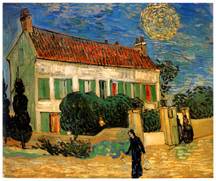SWT class solves historical art, astronomy mystery
| SAN MARCOS, TEXAS — It has all the ingredients of a cloak-and-dagger mystery: a long-missing art masterpiece, Nazi oppression, Communist secrecy, and, finally, what the heck is that star in the sky anyway? But the historical puzzle that spans more than a century and crosses several international borders was not solved by double agents in trench coats. Instead, it was carefully pieced together by honors students and their professors at Southwest Texas State University. In an article published in the April edition of Sky and Telescope magazine, SWT physics professors Don Olson and Russell Doescher and an SWT honors astronomy class describe how they came to learn essentially all there is to know about a recently rediscovered painting by impressionist Vincent Van Gogh. In an uncanny burst of productivity, Van Gogh completed more than 70 paintings in Auvers, France, during the 70-day period before he took his life in 1890 at the age of 37. One of those paintings, White House at Night, had been lost to the art world for more than a half century before resurfacing in 1995. How it came to be lost involves a certain amount of political intrigue. During the 1920s, the painting became part of the collection of German industrialist Otto Krebs. After the Nazis rose to power, the painting was driven underground because of fear of political reprisals against the owners of modern art. After World War II, it became part of the plunder spirited back to the Soviet Union by the victorious Russian army. And there it languished in obscurity behind the Iron Curtain until 1995, when its existence became public knowledge in the catalogue for an exhibition of hidden art treasures in Russia’s Hermitage Museum. |
|
White House at Night became the fifth known painting of a night sky by the impressionist master, and a particularly bright celestial body in the painting piqued astronomer Olson’s curiosity. Olson and his frequent collaborator, fellow physicist and astronomer Doescher, have established reputations for using the science of astronomy to solve historical puzzles and mysteries. They have examined other Van Gogh night sky paintings in previous projects.
A closer examination of the newly rediscovered painting seemed a natural for the pair and for the students Olson teaches in his honors course, Astronomy in Art, Literature and History. In particular, they wanted to identify the bright object in the painting’s night sky. “To make a convincing identification of Van Gogh’s star, we needed to answer four questions: Does the painting depict an actual house? Could we find this distinctive house in present-day Auvers? What is the orientation of the house? What part of the sky is shown in the painting?” said Olson. To answer these questions, Olson, Doescher and 10 of their students traveled to Auvers during the spring of 2000. There, during a four-day stay, they successfully located the house depicted in the Van Gogh masterpiece, no small accomplishment in itself because the identity of the house in the painting had been the subject of debate locally in Auvers for years.
They established its orientation and realized Van Gogh had painted the picture looking toward the western horizon. They knew Van Gogh had described the painting in a letter written to his brother on June 17, 1890. Because they also knew Van Gogh was churning out paintings at a remarkable pace at that time, they surmised the painting was done shortly before June 17. Checking historical weather records, they found a period of heavy rain and cloud cover from June 7 until June 14. While the skies began to clear on the 15th, it wasn’t until the 16th that clear blue skies prevailed. By the 17th, the weather had turned foul again.
Planetarium computer programs show that the planet Venus would have been the brightest object on the western horizon on June 16, 1890, and in the location depicted in the painting at about 8 p.m. Olson said it is the third of Van Gogh’s five known night sky paintings to feature the planet Venus, the others being Starry Night and Road with Cypress and Star.
“We have gone from knowing almost nothing about this beautiful painting to knowing almost everything there is to know about it,” said Olson.
